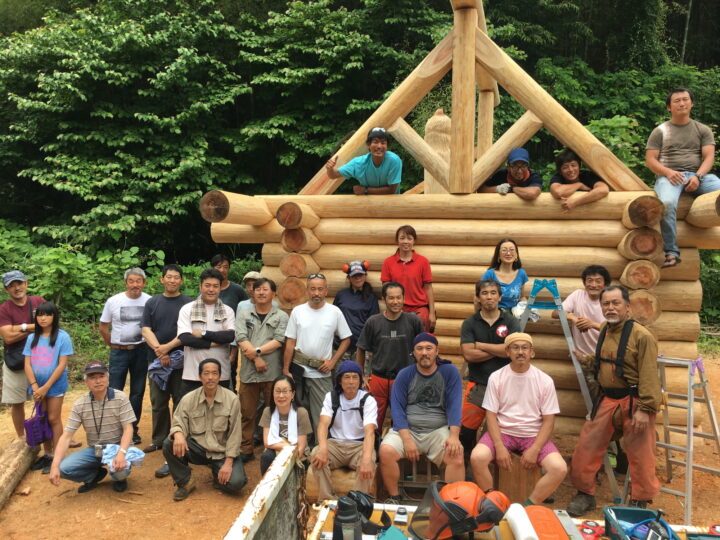
Passing on the Craft of Log Building
In December 2013, Allan Mackie, accompanied by Dai Ona, made his last visit to Japan and attended a gathering, much like a family reunion, of Japanese B Allan Mackie Log Building (BAM) graduates. At the end of the gathering, Allan suggested that the graduates should form a group that can get together once a while and do something good. From this gathering, a group was formed and called Harmony With Nature (HWN). For two years this group of approximately 35 members, worked to assist areas, homes, and peoples affected by disasters, including 3 days spent digging out a log home submerged from a mudslide.
In the Spring of 2016, the group discussed the benefits of running a BAM course again in Japan. Dai himself had been running BAM between 1996‐2003 on Vancouver Island, and though he has since stopped running the course, Dai believed this was a great opportunity to pass on some great knowledge.
With short notice, a team of six volunteer instructors were assembled. All were well known and experienced builders from north, south, east and west Japan, and Dai from Canada. Eager to pass on their knowledge and share their passion for the craft; some instructors drove over 12 hours and some took a train to participate in passing on their knowledge and skills. It was the kind of dream team that would never have been assembled for a regular course, however with the HWN concept, instructors were happy to volunteer.
On June 18, 2016, eight eager students, ages 28 – 64, came together at Woodsmans Village, Nikko, Japan to learn the craft of log building during an eight-day course. The course featured the building of 10” x 10” full scribe log shell complete with a roof system. Originally the course was to take place during regular eight-hour work days, however the motivated students requested that the course run extended hours so they could participate and see the completion of the roof system resulting in students and teachers working and learning together from 8:00 am to 9:00 pm each day.
Students and instructors alike had a great time and all involved confirmed it was worth the time spent to learn and to pass on the craft, even though there was no economic benefit to the participants or instructors. The success of the course was obvious and upon conclusion emotions ran deep and a few people were even in tears. These students walked away with new found knowledge and skills and unbridled enthusiasm of a craft.
Dai believes that it is new blood coming into the industry that will keep the craft of log building alive. He recognizes that it’s getting the craft to the new blood that is the challenge. Dai feels that as time has passed since B Allan Mackie Log Building courses first came about, the craft of log building is at risk of being lost due to new regulations and too few training events being held to keep the craft alive. He still believes that log building is one of the easiest building methods, and is a better method that not only results in unique log structures but is also good for building character and confidence as it allows the craftsman to feel the satisfaction of constructing something with ones’ own hands. The fundamentals taught in the BAM courses demonstrates this and aspires to enable those who desire to build their own home.
Dai has been maintaining the legal status of the B Allan Mackie School of Log Building since he stopped running regular courses in 2003. He is hopeful that the BAM course can be carried on and is interested in having someone or another non-profit organization take the lead to ensure the BAM legacy, the fundamentals of the craft of log building is not lost. He feels strongly that it would be a shame to let this school and craft slip away. Dai is passionate about the structures that students build during BAM courses and says, “I always like the school house project a lot, it may not be pretty in details but I can feel the positive energy that is created by many hands involved in building them”.





